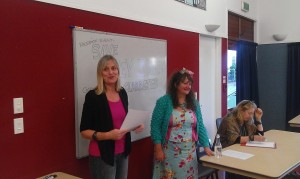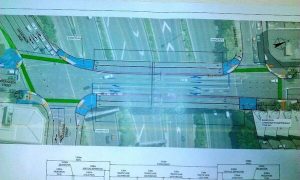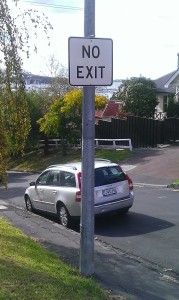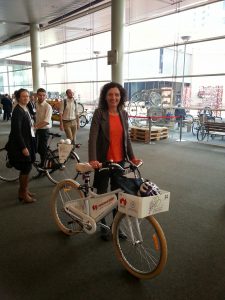 I attended a very special celebration of cycling at the Velo-City 2014 conference in Adelaide in May with member Christopher Dempsey from the Waitematā Local Board. It was the first time the world’s premier cycling planning conference has been hosted in the southern hemisphere to offer opportunities for cycle advocates, practitioners, decision makers, policy makers, planners, engineers etc. from around the world to come together for four days to discuss ways to create and sustain bike-friendly cities. The conference provided valuable lessons from countries and cities where cycling is a valued part of daily transport and recreation.
I attended a very special celebration of cycling at the Velo-City 2014 conference in Adelaide in May with member Christopher Dempsey from the Waitematā Local Board. It was the first time the world’s premier cycling planning conference has been hosted in the southern hemisphere to offer opportunities for cycle advocates, practitioners, decision makers, policy makers, planners, engineers etc. from around the world to come together for four days to discuss ways to create and sustain bike-friendly cities. The conference provided valuable lessons from countries and cities where cycling is a valued part of daily transport and recreation.
Like Auckland, Adelaide has got a long way to go to be a great place to cycle but it was encouraging to see a recent commitment to cycling with new bike lanes and bike parking.
The key themes I took away from the conference are:
- the importance of a connected network that integrates cycling into the transport choices available;
- understanding and selling (via data) the economic, safety and health benefits for everyone of investing in cycling infrastructure; and
- if we are going to meet the challenges of our time and grow as a sustainable city we must act to make cycling (and walking/riding) a priority (we can’t afford not to)
Here are some of my conference highlights from the many speakers:
 Janette Sadik-Khan: Bike to the future (transformational leadership in action)
Janette Sadik-Khan: Bike to the future (transformational leadership in action)
The former NYC Commissioner of Transportation came to Adelaide straight from a tremendous Auckland reception and Auckland Conversation presentation (including a Frocks on Bikes ride which was one of the most inspiring, fun and exciting bicycle rides I’ve ever been on). Some of her key points:
- In NY the mayor took a long term view and sought to put in place a “course correction” to really transform NYC streets. The streets have been reimaged
- Younger people want choice and want to NOT have the burden of owning a car
- Choices on how we prioritise our streets will have an impact for generations to come
- Safety in numbers has been demonstrated with NY streets safer than at any time in the last 100 years – speeding by cars has dropped by 75% on streets with cycle lanes
- Economic benefits of sustainable streets – 50% increase in retail spend
- Budgetary constraints are not an excuse- in NY cycling infrastructure is still only 1% of the budget
- Good streets are safe and good for business (it is not zero sum game)
- She said that bike lanes can truly transform a city and that most of the beneficiaries aren’t even cyclists.
- When people are provided with choice they vote with their feet
- Look at it from a business perspective – you couldn’t make no changes to your major asset for 50 years and expect to still be in business
She emphasised the importance of public consultation and that in NY they relied extensively on public outreach that provides the opportunity to better understand what people’s key issues are and that by helping them with these issues, it’s often possible to turn one’s biggest opponents into huge advocates.
Key message: So many to chose but I liked her observation that people are ahead of the press and politicians
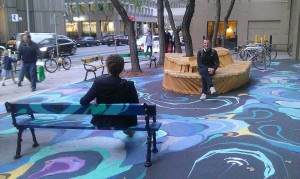 Ethan Kent Place to Place: Changing the transportation paradigm with place making
Ethan Kent Place to Place: Changing the transportation paradigm with place making
Ethan Kent, Project for Public Spaces is another of the Velo-city speakers that we are fortunate to have hosted in Auckland recently. He is a practitioner of “lighter, quicker, cheaper” for short term trials or experimental projects.
- He asks the question what if we planned streets as places
- Place- led planning engages community in a much more holistic, sustainable and productive manner than a project, discipline or even context driven approach.
- Proposed that planning should start with place concepts/aspirations and then allow specialists to develop concepts/options to deliver these outcomes.
- He noted that when parking is an issue/problem, it’s usually a good indicator that a city doesn’t have a big enough vision for itself.
- He acknowledged the importance of the advocates – many of PPS concepts were put into practice in NYC
- He sees place making as a convergence of movements (climate change, smart growth, civic society, local economics, local food systems, historic preservation, community engagement)
Key message:
If you plan for cars and traffic you get cars and traffic
If you plan for people and places you get places and people
(I also attended a place making workshop with Ethan and will report on this separately)
Bojun Borkman-Chiswell: Bicycle journalism, solo film making, the unearthing of a global cycle and the almost certain future of cities
 In a challenging and confrontational presentation Bojun brought a feminist perspective to the conference. She gave voice to women all around the world who rely on the bicycle but are being severely disadvantaged due to the politics of road funding and building.
In a challenging and confrontational presentation Bojun brought a feminist perspective to the conference. She gave voice to women all around the world who rely on the bicycle but are being severely disadvantaged due to the politics of road funding and building.
She called on the male sports culture dominated bicycle conversation to stop to make way for women. She said we need to look at the emancipation of women as the key to returning liveability to our cities.
(The conference opened and closed with all male presentations and out of 29 plenary speakers only 6 were women)
Key message: Make it fun, free and fashionable and women will ride
Niels Hoe: Cycling as the engine for financially and socially sustainable cities
The people in Copenhagen are the happiest on the planet and says Niels it is no coincidence that it is also a great place to cycle. His presentation focused on the economic benefits of a city for people who walk and bike – those that have the time to see what is in the shop window
- Accessible and better streets = more revenue
- Drivers spend more per visit but shop less often
- To encourage shopping by bike – make it easy and convenient
Key message: Cycling is good for business
Dr Lawrence Frank: New research on the health impacts of land use and transportation investment decisions: new tools to support evidence based decision making
He noted the huge health benefit savings of moving from a car-dependent culture to a community that integrates active modes of transport. The quickest thing we can do he says to meet the challenges of our time (global warming, obesity crisis) is reappropriate road space.
His research showed that whether we will change our behaviour and our travel choices are influenced by where we live and what form of travel is intuitive.
- 3.43 times more likely to meet physical activity targets if take public transport
- Every extra hour in a car translates into 6% increase in obesity
- Need to enable people to inhibit health promoting behaviours they want and we are not providing for this
Dr Frank’s presentation highlighted the importance of including the health benefits of walking and cycling improvements in any cost benefit analysis
Key message: Nothing great was ever achieved without enthusiasm!
Jonathan Daly: is separation the answer?
 In a session on treating our streets as public space, behaviourologist, urbanist and designer, Jonathan Daly challenged the decision makers to ask the right question (and to look at who is asking the questions).
In a session on treating our streets as public space, behaviourologist, urbanist and designer, Jonathan Daly challenged the decision makers to ask the right question (and to look at who is asking the questions).
He says that if the starting point is that it is all about infrastructure this becomes problematic. If the answer always is separation this can end up creating more problems than it solves.
- It is not surprising that everyone drives as driving is intuitive while cycling is not
- He focused on re-building cooperation in our shared spaces rather than looking to separation
- If end up with separation around schools then haven’t created the right environment
Key message: There is no silver bullet – a whole lot of things will make an environment intuitive.
Leadership challenges in treating cities as public space: Presentations from Mayoral representatives from around the world:
In Copenhagen currently 41% people cycle to work but the target is 50% by 2015
- The Mayor asked how can we afford to not find space to invest in cycling
- Cycling shouldn’t be an aim in itself but the means
 If you want people to meet and interact get them out of their car so they use their feet was the message from Vienna.
If you want people to meet and interact get them out of their car so they use their feet was the message from Vienna.
- Slower speeds in Vienna with 2/3 of streets now 30km
- A great analogy for supporting bike and car share “If you want a glass of milk you don’t have to buy a cow”
- A good city means dialogue and controversy – getting people engaged in their environment and its transformations can only be a good sign of things to come
Lord Mayor of Adelaide, Stephen Yarwood gave a presentation on leadership aimed at elected representatives with his 8 key points.
- Motivated people achieve great results
- Connect to your community and ask questions
- Communicate results
- Change is hard – we are programmed not to like change. Only reason don’t like change if it is badly communicated
- Make mistakes – have to make mistakes but have fun when doing it
- Dare to dream – just look at the transformation of Melbourne over 20 years to see what is possible
- Be frank and fearless
- Reflect the mood of the city – be the change you want to see
Steven Fleming: inventing building typologies and urban morphologies that proceed from bicycle motion
Like other speakers Steven spoke about our cities being intuitive to drive but not cycle. He looked at design to convince women to live in bike- focused housing . For example being able to take a cargo bike right into the kitchen (like the car in the internal garage)
- He thinks that walkable city make you bored, fat and trapped
- Activity nodes (rather than a central activated place) – let bikes shrink the gaps in between
- Architecture precipitated the age of the car – can do the same for the age of the bike
Craig Richards: bike riding is booming – but is the current progress quick enough?
The Victorian advocacy group Bicycle network has a campaign to petition the PM of Australia to commit $7.5bn to fund $7500km of cycle lanes based on the following simple numbers:
- The number of people becoming inactive is 20x more than taking up cycling
- 63% of Australians are inactive
- Inactivity costs $13.8bn per year
- 59% of people want to ride a bike but are concerned about cars and trucks
- Separated lanes and paths will overcome their concern
- If 59% of people take up riding Australia will save $8.1bn per year
- $7.5bn will buy 7500km of separated bike lanes and paths
- It will transform Australia into the most bike friendly and physically active country in the world
Timothy Papandreou, Director of Strategic Planning & Policy at the San Francisco municipal transportation agency: how SF is tripling bike share mode by 2018
 Following on from Janette Sadik –Khan I think Tim (photo right) was one of the most relevant speakers for Auckland because San Francisco has adopted many of the same strategies as NY to achieve sustainable streets with impressive results. Like Auckland, SF also has one agency and is taking a multi-modal approach. Some of Tim’s points:
Following on from Janette Sadik –Khan I think Tim (photo right) was one of the most relevant speakers for Auckland because San Francisco has adopted many of the same strategies as NY to achieve sustainable streets with impressive results. Like Auckland, SF also has one agency and is taking a multi-modal approach. Some of Tim’s points:
- Driving is the distraction not texting
- Describing people as “cyclists” or “pedestrians” is divisive – in SF they just focus on people
- Opportunity to achieve a 15-30% reduction in cars
- Virtuous cycle of integrated investments
- Progressive parking demand management plan is the most important tool to create more sustainable streets and promote alternative transport options
- Trifecta needed to make cycling happen Mayor/leadership + advocates + “plangineers”
- Quick and easy wins – eg pedestrian build outs designed with paint
- Get the parking right before put in the cycle lanes
- Use lots of green paint and signage
Key message: All politicians in SF now run on a platform of “complete” streets- won’t win and look foolish if don’t
Florian Lennert: Mobility for future cities
The conference closed with Florian Lennert of Innoz who discussed intelligent cities using Berlin as a prime example.
- Future of mobility will be future of urban mobility
- 90% of the time only 1 person occupies a car which is very inefficient mobility
- While cities are meant to be urban spaces for people, the focus has changed to make them about ‘the car’ and this needs to be challenged.
- But it is not just about the bicycle – instead the transport alternative that makes sense. Private car ownership in cities doesn’t make sense for most people, (electric) car sharing however is progressive alternative. Beyond bikes, other small mobility devices such as Segway or even (kick) scooters can be highly effective transport options in cities.
- Shift to multi – modal behaviour which in the German experience has led to a 20 % drop in car use
Key message: The future = multi modal sustainable mobility on demand
Data data data
“In God we trust – everyone else bring data” – Mayor Bloomberg (quoted by Janette Sadik-Khan in her presentation). Some examples of the data presented at the conference:
- Investment in cycling on 9th Avenue led to a 49% increase in business
- A study of a park and ride in Perth showed that 80% had travelled LESS THAN 800m
- The “green dividend” in Portland has saved the city $1.2 billion through cycling before even factoring in the health benefits
- In Germany only 16% of people are traditional car drivers who won’t consider alternatives
- For $60m it is possible to build 300 km of cycle way or 1 km of motorway
The Auckland team
 It was slightly surreal to be celebrating the installation of one bike corral in Auckland at a conference dominated by bike-friendly countries with bike parking buildings for 30,000 bikes.
It was slightly surreal to be celebrating the installation of one bike corral in Auckland at a conference dominated by bike-friendly countries with bike parking buildings for 30,000 bikes.
But regardless of what you think of the video made to show at the conference (described by Transport Blog as “tone deaf”) even the Europeans were impressed with the research that Auckland Transport has undertaken on the use of the bike corral and the economic benefits. Anja Vroegop (Auckland Transport – Community transport team) presented the evaluation of the trial including:
- $1.14 spent per minute compared with car of $1.18
- At peak the bike corral generated $684 per hour compared with $70 for one car park that it replaced
Three other members of the Auckland Transport team gave presentations at the conference. I’ve asked them to present to the Waitemata Local Board at one of our workshops so that all members can have the opportunity to discuss what we learnt from the conference.
Christopher Dempsey in his presentation in the last (but well attended) session of the conference themed “peddling cycling to the pollies” said that he had more rights in New Zealand as a gay man than as a cyclist.
Attendance costs
 My conference registration and my airfare to Adelaide were paid for from the Local Board professional development budget.
My conference registration and my airfare to Adelaide were paid for from the Local Board professional development budget.
Thank you for the opportunity to attend the conference. I came away grateful to have been inspired by amazing people who have achieved fantastic results.
It can often feel that we have an overwhelming amount to do to provide genuine transport choices in Auckland and that we are never going to get the cycling network built (in my life time anyway). Therefore it was encouraging to hear Janette Sadik–Khan say on her visit that it felt to her as if Auckland is at a tipping point and has the potential to be a great place to cycle. As she says – it is just going to take vision, political courage and advocacy.
 We then joined a panel discussion Overcoming resistance: the politics of change with keynote speakers Janette Sadik-Khan (link to the Frocks on Bikes ride with JSK on her visit to Auckland ) and Salvador Rueda, and Wellington City Council Deputy Mayor, Laurie Foon with Session Chair Joel MacManus.
We then joined a panel discussion Overcoming resistance: the politics of change with keynote speakers Janette Sadik-Khan (link to the Frocks on Bikes ride with JSK on her visit to Auckland ) and Salvador Rueda, and Wellington City Council Deputy Mayor, Laurie Foon with Session Chair Joel MacManus.




















